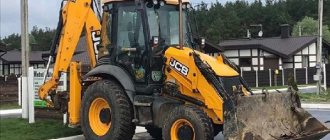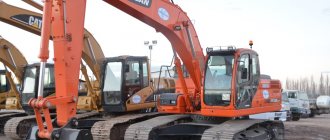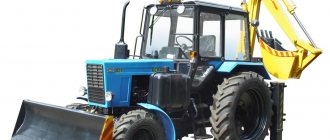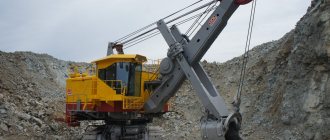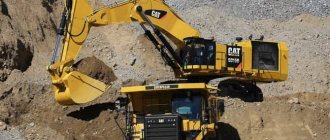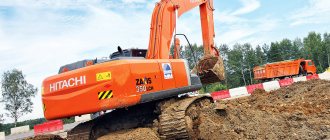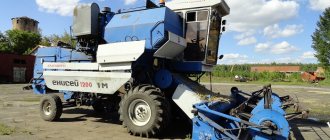This direction has become widespread in the construction engineering industry and, in particular, in the introduction in construction of this type of equipment such as a mobile crawler excavator to replace complex and labor-intensive railway steam shovels. However, the First World War and the subsequent economic crisis in most countries caused a sharp slowdown in the pace of creation of new technology.
In the USSR (Russia), excavator building as a branch of mechanical engineering arose in the first half of the 30s, and in the pre-war years, 2086 single-bucket excavators were produced at five factories, mainly on tracked running devices. During World War II, the production of excavators practically ceased. The colossal tasks of rapid post-war reconstruction and development of the country's national economy required equipping industry with modern construction machines. The organization of VNII-Stroydormash and design bureaus at factories in 1946 allowed a number of enterprises to specialize in the production of excavators in the shortest possible time and rapidly develop their design and mass production. The production of single-bucket excavators increased from 76 in 1946, to 11,622 units in 1960, to 28 thousand in 1970 and exceeded 35 thousand in 1985. In the early 60s, the USSR (Russia) took first place in the world in terms of production of excavators.
After the Second World War, a number of industrial countries also saw a sharp increase in the production of single-bucket excavators. This was especially true for the USA, Germany, France, England, and Italy. The experience of Japan is very indicative, where, due to an increase in the volume of construction work, the production of single-bucket excavators has received great development, especially since the mid-60s. The approximate dynamics of production volumes of these machines in Japan is as follows: 1965 - 2500 units, 1972 - 16200 units, 1975 - 19000 units, 1980. - 57,500 pieces, 1986 - 61,000 pieces, 1989 — 82500 pieces, 1993 - 80,000 pieces, 1996 - 80,000 pieces. In the post-war period, as in other countries, in Japan, at first, mechanically driven excavators were primarily produced; their maximum annual production reached 2,500 units by 1970, and then began to gradually decline due to replacement by hydraulically driven excavators. These more advanced machines in terms of their design and operational characteristics began to be produced in Europe from the mid-50s, and in Japan - from 1961, where by 1987 the production of mechanically driven excavators decreased to 500 units per year, of which more than 28% there were machines with buckets with a capacity of 0.6 m3.
Main advantages of hydraulic excavators:
- a significant increase in the productivity of new machines compared to the ones they replace, which have a mechanical drive;
- reduction of specific material consumption and specific energy consumption of machines;
- expanding the versatility of hydraulic excavators due to replaceable working equipment and working parts up to 25-40 items;
- workflow automation;
- radical improvement of control systems and creation of comfortable working conditions for the driver;
- improving the aesthetic appearance of cars;
- radically improving the driving performance of vehicles.
Over the past 50 years, active work has been carried out in the USSR (Russia) to create, expand the range and improve excavators with various types of drives, running gear and replaceable types of working equipment and working parts. This entire half-century period can be divided into three main stages:
- In 1947-1953, first of all, the design was developed and mass production of excavators with mechanical drive and buckets of 0.25-1.0 m3 was mastered at specialized factories.
- In 1954-1967, the creation and production of a whole range of construction excavators with 0.15-2.5 m3 buckets, with various drives and running devices was completed, including mounted hydraulic excavators and the most powerful construction excavators with a multi-motor electric drive. The EO-5111E excavator was produced (Kostroma Excavator Plant) with dragline equipment and tracked equipment, weighing 33.3 tons. During the same years, a deep modernization of most excavator models was carried out in order to increase their productivity and the production of machines in the northern version was mastered.
- In 1968-1995, a huge amount of work was completed to create a whole range of construction full-rotary hydraulic excavators with articulated and telescopic working equipment and to replace excavators with rope suspension of working equipment with these machines. Serial machines were continuously improved, their productivity and reliability increased, ergonomic indicators and artistic and design solutions were improved.
| Model EO-4225A (Kovrov Excavator Plant) weighing 26.5 tons. | Hydraulic excavator Tveks ET-25 (Tver Excavator Plant) |
At the same time, for all size groups of hydraulic excavators, the design of dozens of types of replaceable equipment and working parts was developed, and mass production of a large range of hydraulic equipment and equipment, as well as other standardized components for mechanisms and control systems of excavators, was created and mastered.
American and Western European excavator-building firms worked on the creation and development of production of construction single-bucket excavators in approximately the same ways and within the same time frame.
The Japanese experience has its own characteristics. The introduction of hydraulically driven excavators in Japan occurred in three stages. At first, machines purchased abroad were used. Then Japanese companies began to master the production of hydraulic single-bucket excavators under license with the technical assistance of European and US companies, cooperation with which sometimes lasted over 10 years. But due to the fact that the design of these machines was developed by foreign companies and the requirements of Japanese consumers and local operating conditions were not completely taken into account, the national industry of Japan switched to the creation and production of its own excavators. The first in the Japanese markets were hydraulic machines on a caterpillar undercarriage weighing 6-8 tons, and then they began to produce pneumatic wheeled excavators with buckets with a capacity of 0.3-0.4 m3. Subsequently, their power began to increase, and machines weighing 10-20 tons were introduced into production.
The demand for this type of equipment gradually increased. If in 1965 their sales amounted to 900 units, then in 1966 it increased to 2000 and in 1967 to 3000 units, reaching 5000 units in 1968. At the same time, the expansion of the range and improvement of the quality of machines was developed. More than 11 Japanese companies were involved in this. The first stage in improving hydraulic excavators was to increase the power of power plants and machine performance, as well as improve their driving characteristics. Competition arose between companies to improve the technical characteristics of excavators, create new models and improve their design. Models of machines were developed designed to work in urban environments and for other places of operation. In the second half of the 70s, the hydraulic excavator became widespread in Japan and became one of the main means of mechanizing work in construction.
It was during this period that a sharp increase in engine fuel prices was noted in the industrialized countries of the world, which was associated with the well-known fuel crisis and required accelerated improvement of hydraulic drive systems in order to reduce fuel consumption. The operating pressure in hydraulic systems was increased and pumps with a constant supply of working fluid were replaced on many models of machines with pumps with variable supply, which increased the efficiency of the drive and the efficiency of using engine power. At the same time, in every possible way, they reduced the pump flow, reduced the idle speed of the engines and minimized power losses in hydraulic systems under various operating modes.
In the early 80s, control systems on many models of single-bucket excavators were improved through the use of servo devices, and more comfortable conditions were created in the driver’s workplace, especially by reducing noise levels. To meet all the requirements for earthmoving equipment, electronic equipment began to be introduced into their hydraulic systems in the 80s, both for engines and for pumps and control systems.
| Hydraulic excavator CASE-POCLAIN 1288 LC | Hydraulic excavator DAEWOO 280 LC |
In the 90s, all companies paid great attention to the appearance of their cars; driver's workplaces in their decoration were close to luxury salons; the use of air conditioners was standard. The scope of application has been significantly expanded due to the installation of new types of working equipment and working bodies. This made it possible to widely use them in the dismantling of buildings, for laying tunnels, in the development of stone materials and in forestry. In recent years, increased environmental requirements have been imposed on hydraulic excavators in terms of environmental protection, in particular to ensure low levels of external noise and to regulate the composition of engine exhaust gases.
In addition, manufacturers of bucket excavators pay serious attention to compliance with safety standards, which is facilitated by their active participation in the development of international standards within the framework of ISO Technical Committee 127, Earthmoving machines. Due to meeting diverse demands, hydraulic bucket excavators have become a basic equipment that is in high demand. Thus, in the 80s and 90s, the maximum consumption of these machines on the domestic market in one country was identified in Japan. In 1996, of the 97,800 hydraulic excavators sold worldwide excluding mini excavators, Japanese consumers purchased 48,400 units, or approximately 50%. In addition, Japanese manufacturing companies supply excavators to many countries around the world, not counting their production in England and Italy. Special negotiations are also underway to establish the production of excavators in other countries.
Among all types of universal machines, tracked ones occupy a leading position, since they have no weight restrictions compared, for example, with wheeled excavators. The most widespread in most countries are hydraulic excavators weighing from 10 to 50 tons, which perform the bulk of excavation work in industrial and civil construction, as well as in other industries. The table below shows brief technical characteristics of the most typical hydraulic driven excavators of domestic and foreign production. Below are the design features and development trends of the main systems, mechanisms and working equipment of these machines.
Power plants and hydraulic systems
Domestic machines mass-produced by the Tver, Kovrov and Voronezh factories use double-flow hydraulic drive systems from automatic adjustable pumps with manual flow combination and group parallel-series power supply to hydraulic motors. The improvement of promising domestic single-bucket excavators is carried out taking into account the experience of foreign companies.
For example, Liebherr produces machines using the Litronik system, which is applicable for excavators of various capacities. The Litronik system is the control of hydraulic valves, the engine, the pump, the monitoring and display of information on the operation of the engine and hydraulic system, and an alarm in case of deviations from the normal operation of the drive. However, by special order of the consumer, a system for running the engine at reduced fuel supply in the event of no drive load during technological breaks can be installed.
The pump has systems: cut-off, zero-setter, secondary regulation. The ECO system is used to control the engine in three modes, corresponding to heavy, general purpose and light work. The electronic control system provides engine control in the mode of using full engine power or part of the engine power.
The hydraulic system is equipped with a hydraulically controlled seven-spool monoblock hydraulic valve. Flow summation is provided for the hydraulic mechanisms of the arm and boom. It is possible to combine all movements of the elements of the working equipment with the rotation of the platform and the movement of the excavator.
Komatsu and other Japanese companies use an LS type hydraulic system with hydraulic valves having an “open” center, which regulates the supply of working fluid depending on demand. This system also has a pressure cut-off, which ensures that the pump's pumping unit is moved to a position close to zero, while maintaining pressure on the working element when it is put into stop mode.
When using the LS system, fuel savings and a reduction in noise levels are achieved by reducing various power losses in the hydraulic drive (losses when the control levers are in the neutral position, losses due to throttling, losses during high-precision control).
Thanks to the use of a hydraulic system with a combination of flows to power the hydraulic cylinders of the handle, priority power supply to the hydraulic motor for turning the platform, a high speed of movement of the handle and effective combination of its movements with the rotation of the platform is achieved. As a result, combined with high forces on the working body, a single-bucket excavator has a minimum working cycle time and, accordingly, increased productivity. Hitachi's 44-tonne excavators use the ETS (electronic electronic control) system, which also includes a rapid heating circuit for the working fluid and a shock-absorbing valve. The system allows you to improve the technical and operational performance of excavators, reduce fuel consumption and noise levels.
A number of Caterpillar-Mitsubishi single-bucket excavators use an “electronic power plant control system” and an “operating mode selection system.”
The power plant control system provides two types of control: switching power modes and automatic engine control. Depending on the operating load conditions, three-stage switching of pump power is provided. The precision control mode is selected when performing operations involving low loads, as well as when trenching and other operations that require increased precision of the movements of the working body. The universal mode is used for ordinary excavation work with high productivity. Heavy duty mode can be used in harsh operating conditions when the engine is running at maximum power.
The engine management system allows you to automatically reduce engine speed when you move the excavator control levers to the neutral position, which helps reduce fuel consumption when waiting for dump trucks and other technological downtime.
The system for selecting operating modes makes it possible to change the operating characteristics of the machine in accordance with the nature of the work and the flawless performance by the machine of those actions that the operator needs. This is achieved by choosing three options for operating the excavator’s hydraulic system during accelerated development and loading of soil, when excavating trenches and when precise control is required, for example, when leveling sites.
Excavators from Kobe (Japan) use turbocharged diesel engines directly connected to pumps that have limit control of the total power, a system for reducing the engine shaft speed and a system for switching machine operating modes, which ensures the simultaneous achievement of high operational productivity and fuel economy.
The main tasks that are set when creating a new machine in accordance with modern requirements, also imposed by domestic and international standards for hydraulic full-rotary excavators, are to increase technical and operational productivity; increase in operating parameters; reduction in specific material consumption; improvement of the hydraulic drive and design of the main mechanisms and assembly units; improving the conditions for machine maintenance and operator work. To carry them out, a set of design solutions was implemented on the new EO-5225 excavator, which distinguish the new machine from excavators of the same size group, previously created at the Voronezh Excavator Plant. As a result of the work carried out, almost all parameters of the single-bucket excavator EO-5225 were significantly improved compared to domestic and foreign analogues.
The power plant on the new machine is a YaMZ-238B turbocharged diesel engine with a power of 300 hp, which is 67% more than the engine power of the replaced EO-5124A excavator. A gearbox with two automatically controlled axial piston pumps with a volumetric flow of 160 cm3/production revolution is attached to the flywheel housing of the YaMZ-238B engine. The use of such a power plant allows not only to increase the value of many parameters of the EO-5225 excavator, but also to increase the service life of the diesel engine.
In accordance with GOST 30067-93 “Single-bucket universal full-rotary excavators. General technical conditions" the main working equipment for the excavator is a new design backhoe with a bucket with a nominal capacity of 1.85 m3. In addition, the machine has interchangeable types of working equipment: a straight shovel, a rigid grab, a hydraulic hammer, a tooth ripper, as well as interchangeable buckets of various capacities and purposes.
Equipping the EO-5225 single-bucket excavator with new working equipment for backhoes and forward shovels in combination with increased power of the diesel engine and pumping unit of the hydraulic drive system makes it possible to increase its technical productivity by 30-35%. A hydraulic distributor of a new design is installed on the EO-5225 single-bucket excavator, which improves the machine’s control system, helps to increase its productivity and reliability, and significantly simplifies the layout of hydraulic pipelines.
318D2L
The crawler excavator of this model has increased power to 84 kW. The operating weight has also increased (17.8 tons). The model also differs from its predecessors in improved handling and a high level of comfort, which makes it a universal and functional tool for performing diverse production, road and construction tasks.
The 318D2L excavators feature powerful electronically controlled Cat C4.4 ACERT drives and meet industry leading environmental standards in the US, Japan, China and the EU. Together with an efficient hydraulic system, these engines provide excellent performance with economical fuel consumption. High-strength load-bearing structures of the excavator can withstand significant operating loads, which allows the machine to be used in the most difficult conditions. The cab offers excellent visibility, helping to ensure a safe working environment on site.
Turntables with mechanisms
On the rotating platform of hydraulic excavators, a power plant, units and components of the drive system, a turning mechanism and a driver’s cabin with a control panel are placed.
When developing the design of a turning mechanism, two main tasks are solved: creating a compact unit and ensuring efficient operation of the machine during the process of turning the platform. The first problem is solved by using planetary gearboxes on many excavators, the second is by using an independent drive of the turning mechanism and a modern control system.
To prevent arbitrary rotation of the platform when the excavator is on slopes, as well as to safely carry out operations with a load on the hook, Komatsu installs a parking brake on the turntable.
| Hydraulic excavator EO-5225 (TYAZHEKS) | Hydraulic excavator EO-4228 (JSC KEZ) |
Firms mainly use the traditional layout of units. Some companies use a longitudinal central or longitudinal lateral engine arrangement. Hydraulic distributors are placed near the boom or directly on the boom, while installing the boom hydraulic cylinders with the rod down. It is characteristic that Case-Poclain has abandoned the use of high-torque hydraulic motors of its own manufacture in the mechanisms for turning the platform and moving hydraulic excavators and in recent years has been using a gearmotor from Volvo (Sweden), which organized their special production.
Liebherr uses a hydraulic motor and a planetary gearbox of its own production to drive the turning mechanism. In the swing drive, the normally closed disc brake built into the gearbox is stopped; The slewing ring is sealed.
On the EO-5225 excavators of the Voronezh plant, to improve vibration and noise indicators in the cabin, a diesel engine with a hydraulic system pump drive gearbox is installed on the platform through shock absorbers.
Calculations
Bucket volume = Nominal volume x Specific gravity of rock
The filling coefficient is equal to the collected soil in one step divided by the volume of the bucket.
Efficient work means filling the dump truck bucket in 4-6 unloadings.
For digging pits, profile and trench type buckets are in demand. Their differences are in the shape, number of teeth and their sharpening, and the angle of inclination of the walls. Reinforced equipment is necessary, as already mentioned, for rocks when creating trenches, canals, and reservoirs.
Cabins and their equipment
In the field of cabin design and creating comfortable conditions for the operator, Japanese companies have achieved certain results through the use of a number of designs: spacious cabins with increased glass areas; comfortable shock-absorbing remote control chairs with seat belts; low-effort control levers; toughened tinted glass; control panel with electronic clock, operating hours counter, information system for monitoring parameters; stereo receiver and air conditioning (on special orders); an opening in the roof to improve visibility, covered with a lid. There is a tendency to simplify the cab shape: without a front bevel they are installed on excavators from Caterpillar, Komatsu, with a front bevel - on excavators from Liebherr, Hitachi.
Since all machines have servo control and a remote control chair, the cabin is designed with a front door. I make the front frame slide under the cab roof. On many models of cars, the cabins have additional windows (sliding windows) or lifting door windows. The instrument panels of most excavators, in addition to water and fuel level control devices, electronic clocks and operating hours counters, are equipped with an electronic information system about the operation of all diesel and hydraulic systems. On some machines, up to 24 parameters are controlled, for example, from Case. In case of deviations from the normal functioning of the main systems and mechanisms of the excavator, the electronic on-board control system notifies the operator using lamps and sound signals.
Work is underway to reduce noise levels in the cabin. As a rule, the diesel compartment is completely isolated by an independent hood or soundproofing partitions (Komatsu and others). A significant result in this direction was achieved on single-bucket excavators EO-5225 of the Voronezh plant. Thanks to the design measures taken, the noise level in the cabin is reduced to 70 dB (A), which is much lower than that of the best excavator models.
Working equipment
Manufacturers of hydraulic excavators are constantly working to improve the main working equipment of machines weighing up to 50 tons - the backhoe. Operating parameters (bucket capacity, digging depth and dumping height) are directly related to the operating weight of excavators. As a result, when designing machines with similar excavator mass values, most companies obtain operating parameters that differ little from each other, as can be seen from the data in Table 1. If any parameter is deliberately changed, this leads to a decrease or increase in other parameters.
In recent years, all companies have also been actively working on the creation, improvement and increase in the number of types of replaceable working equipment and working bodies for the entire range of single-bucket excavators. Depending on the purpose, the range of working equipment and working parts with which excavators are equipped primarily includes various buckets, as well as extended handles, additional handles, extended booms, working equipment with an offset digging axis, shortened working equipment, working equipment for loading timber. , buckets for slope leveling, hooks, buckets with ejector unloading.
Hitachi and Liebherr paid special attention to the development of the design of devices for quickly changing buckets without the operator leaving the cab. A significant expansion of the scope of application of hydraulic excavators was the creation of equipment for them designed for dismantling and destruction of buildings and structures, which is especially important in the reconstruction of cities and industrial enterprises. For the extraction of minerals and building materials in quarries using hydraulic excavators equipped with a straight shovel and a loader, many new types of working bodies have been introduced.
Thus, Hitachi single-bucket excavators weighing 41...44 tons are equipped with a 2.6 m3 loading bucket with an opening bottom and an automatic horizontal extension mechanism. This ensures ease of operation, direct soil development due to high digging forces, and efficient loading of dump trucks in cramped conditions.
Komatsu also equips its 42t excavators with an opening bottom loading system reinforced with a wear plate. The bottom of the bucket is easily opened using a push-button switch at the end of the control lever.
In order to improve maintenance conditions, Kato and Caterpillar-Mitsubishi companies use remote centralized supply of lubricant to the hinges of working equipment located at high heights.
Komatsu also uses a mechanized centralized lubrication system for the hinges of working equipment on large machines with a supply of lubricant for 800-1000 hours of operation.
Where to buy buckets for an excavator?
provides the opportunity to buy a trench bucket for an excavator of the required modification at a convenient price. We will help you choose trailed and mounted equipment with optimal performance characteristics, taking into account the totality of equipment requirements and the specifics of construction work.
Our company supplies high-quality special equipment and components to the Central Federal District, and also sends equipment to customers in other cities of Russia. We also help you choose the appropriate type and model of special equipment to perform certain jobs or individual technological operations. You can contact the manager by phone 8 800 250-60-27 , or through the website’s return form.
Return to Articles section
